Deborah Dark and John Hawkins1
The proportion of Australian domestic expenditure spent on imported goods has been steadily increasing over the past two decades. This partly reflects higher incomes as imports tend to be luxury goods.
A more important influence over the longer term has been the decrease in the relative price of imported goods, reflecting technology and cuts in protection and transport costs. (At times, exchange rate appreciation has further decreased the relative price.) As imported goods have become relatively cheaper, demand has increased.
But imports have increased even beyond what can be explained by movements in incomes and relative prices. For consumption items, this may reflect a preference for variety in goods. Companies are increasingly operating globally, leading them both to import and to export more components and finished goods. This has been facilitated by reductions in barriers to global trade.
Introduction
In the 1960s imported goods were on average around 11 per cent of nominal domestic demand; after increasing steadily they now account for around 17 per cent (Chart 1). As prices of imported goods have risen more slowly than domestic prices, the increase in the ‘volume’ of imports has been even greater — an average annual growth rate of 9percent over the past decade. This paper looks at why this switch of expenditure has occurred, focusing on the causes of strong growth in the past 10 to 15years.
Chart 1: Import penetration ratio
(imports of goods as percentage of gross national expenditure)
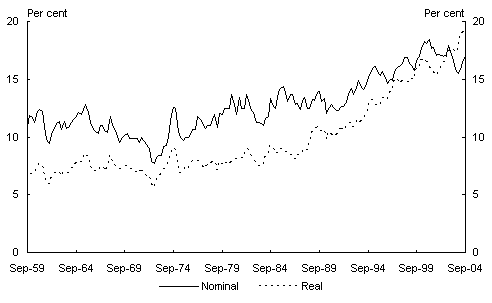
Source: Australian Bureau of Statistics 2004, Balance of Payments and International Investment Position, cat.no.5302.0, Canberra.
Australian Bureau of Statistics 2004, National Income Expenditure and Product, cat. no. 5206.0, Canberra.
Australia imported $133 billion of goods in 2003-04. This is equivalent to an average of $6,700 per person, although many of the goods were imported by companies rather than households. The analysis in this paper concentrates on developments in the imports of goods. Australia also ‘imported’ $34 billion of services. About half of this represents spending by Australian tourists abroad, but it also includes freight charges and payments for other services.
Some of the major types of imported goods are cars($12 billion in 2003-04), machinery($11billion), fuel ($10 billion), food and beverages ($5 billion), clothing and footwear ($5 billion), computers ($5 billion), household electrical goods ($4 billion), telecommunications equipment ($4 billion) and aeroplanes ($3 billion). About a third of imported goods are classified as ‘consumption goods’, used by households. About a quarter are classified as ‘capital goods’, such as machines used by firms to produce other goods. Most of the remainder are classified as ‘intermediate goods’, raw materials and components used by firms to make goods for domestic sale or export.2
A notable change in the composition of Australia’s imports has been Australian consumers and firms buying more information and communication equipment, especially computers. However, despite the significant increase in the number of these goods purchased3, and the increase in their capabilities and quality, the decline in their prices has meant the total amount spent on them as a proportion of spending on imports has not changed significantly (Chart 2).
Chart 2: Imports of information and communications technology goods
(as percentage of total imports of goods)
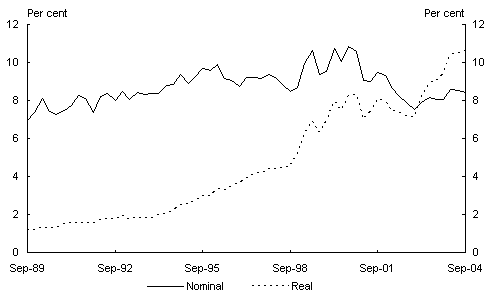
Source: Australian Bureau of Statistics 2004, Balance of Payments and International Investment Position, cat.no.5302.0, Canberra.
The increase in the proportion of spending on imports over the past decade is placed within a longer term context in Chart 3. Abstracting from temporary influences4, the imports share tended to decline until the late 1960s as Australia used immigrant labour and tariff barriers to build up domestic manufacturing to replace imports. Notwithstanding high protection, this policy was seen as a failure, and did not prevent the import share starting to rise again by the 1970s. Policy then changed to a more competitive export-oriented focus. Tariffs were cut across the board by 25percent in 1973 and phased down further subsequently. The import share therefore rose further in the 1980s and 1990s.
Chart 3: Import penetration ratio
(imports of goods as percentage of nominal GNE)
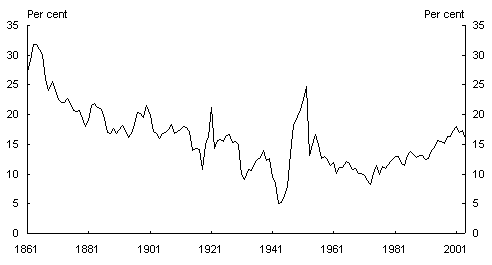
Sources: Vamplew (1987), Australian Bureau of Statistics.
As Australia represents only 1 per cent of global GDP, there should not be any difficulty in the world supplying the volumes of goods that Australia demands as imports. The main drivers of Australian imports are therefore likely to be Australian incomes, prices of imported goods relative to domestically produced goods, and gradual changes to the structure of the Australian economy and changes in tastes. However, it is difficult to assign the increase in imports to these different factors with accuracy.5 The following sections in this paper explore these factors in turn.
Income effects
Part of the rapid growth in demand for imports over the past decade reflects strong growth in incomes. Since the early 1990s there have been no recessions and real GDP has grown at an average annual rate of almost 4 per cent. Spending (real GNE) has grown by around 4percent. This was faster than income growth, and reflected increased wealth and a greater willingness and ability for households to take on debt.
Many imported consumer goods are luxury items such as prestige motor vehicles. As incomes increase, consumers spend a higher proportion of their income on such luxury goods, and hence on these types of imported goods. A substantial proportion of capital equipment is also imported, for example specialised machinery and computers. Investment moves cyclically with GDP and GNE, but more than proportionately (an accepted stylised fact, supported by ‘accelerator’ theories). As the past decade has been one of virtually uninterrupted strong growth in real GNE, it is not surprising that imports of capital equipment have grown faster than GNE over this period. The boom in exports of manufactures in the 1990s would also have added to Australian demand for imports as their import content is about a third.6
Accordingly, most estimates of the ‘income elasticity of imports’7 are greater than 1. The short-run elasticity could be higher than the long-run elasticity if a surge in demand is temporarily met by imports, due to either physical capacity constraints or high costs of sharply increasing production. Alternatively, if there are long lags in ordering and receiving imports, the short-run elasticity could
be below the long-run elasticity.
Single equation estimates within Treasury, including that for Treasury’s economy-wide model, TRYM, and elsewhere suggest the income elasticity is around 1 to 1. This may have increased over time; in Macfarlane’s (1979) survey of studies that use data from the mid-1960s to early-1970s, the income elasticity estimates range from 0.7 to 1.2.
Comparable elasticities have been estimated for similar economies overseas. For example, Krugman (1989) reports income elasticities of 1.3 for the United States, 0.8 for Japan and 1.7 for Canada. More recently, Senhadji (1997) reports a long-run income elasticity of 1.5 for Canada and Hooper, Johnson and Marquez (1998) an elasticity of 1.4 for Canada.
Globally, over the past five decades volumes of exports of manufactures have increased at an annual average rate of 7 per cent while GDP grew by 4percent, suggesting a long-run elasticity of almost 2. However, this was a period of widespread cuts to trade barriers so this apparent high elasticity may not be sustained.
Some cross-country studies suggest a lower income elasticity. For example, Guttmann and Richards (2004) report that total trade (imports and exports) as a proportion of GDP is not robustly related to income, once other explanatory variables are included in the analysis.8 This would imply the income elasticity is around 1.
An alternative way of analysing the effect of increases in income on consumption imports is to examine cross-section data from the household expenditure survey. Dark and Hawkins (2005) look at 26 categories of household spending and make plausible assumptions (drawing on input-output tables) about the import content of each. Imports make up a higher proportion of the expenditure of higher income households. The calculations imply that the elasticity of imports with respect to consumer spending is around 1.2.9
Price effects
The ‘relative price of imports’ (price of imported goods relative to the price of domestic goods) showed almost no net change from the mid-1960s to the mid-1980s, whereas the past decade has seen a steady decline (Charts 4 and 5).
Looking at medium-term trends, while the trade-weighted exchange rate index is now close to where it was in the early 1990s, the relative price of imports has dropped by a third over this period. Part of this reflects continual price declines of computers and telecommunication devices; as Chart 2 shows, these account for about a tenth of imported goods and their prices — particularly once adjusted for quality improvements — have fallen markedly.
Shorter term fluctuations in the relative price in recent years have mostly been driven by movements in the nominal trade-weighted exchange rate (Chart 4), given that inflation has been low in both Australia and most of our major trading partners.
Chart 4: Relative price of imports and trade-weighted index

Source: Australian Bureau of Statistics 2004, Balance of Payments and International Investment Position, cat.no.5302.0, Canberra.
Australian Bureau of Statistics 2004, National Income Expenditure and Product, cat. no. 5206.0, Canberra.
Another cause of imports becoming relatively cheaper for Australian consumers is the reduction in tariffs over time. This has reduced the amount by which the prices paid by Australian consumers for imported goods exceeded the world price for them. As a result, the prices faced by Australian consumers have fallen by more than the world price over time. The magnitude of this effect is illustrated by Chart 5.
Single equations estimated within Treasury, including in the economy-wide model, TRYM, and elsewhere suggest the price elasticity is between - and -1. Macfarlane’s (1979) survey of studies that use data from mid 1960s to early 1970s reported relative price elasticities spread over a range from -0.5 to -1.6, raising the possibility that it may have declined in absolute magnitude over time.
Chart 5: Relative price of imported goods
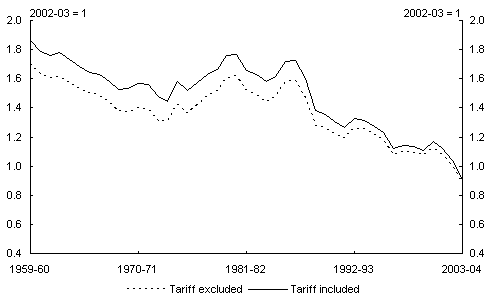
Source: Productivity Commission.
Australian Bureau of Statistics 2004, Balance of Payments and International Investment Position, cat.no.5302.0, Canberra.
Australian Bureau of Statistics 2004, National Income Expenditure and Product, cat. no. 5206.0, Canberra.
There may be substantial variation in the price elasticities across types of imports. Menon (1993) found elasticities ranged from -0.2 to -1.8. Dwyer and Kent (1993) conclude that consumption goods are more responsive to relative prices than are aggregate imports, while intermediate goods are unresponsive, consistent with the lack of readily available domestic substitutes. During the past 15 years, which have been a time of strong growth in imports, the relative prices of capital and intermediate goods have fallen more substantially than that of consumption goods (Chart 6).
Comparable elasticities have been estimated for similar economies overseas. For example, Senhadji (1997) reports a long-run price elasticity of -1.3 and Hooper, Johnson and Marquez (1998) report an elasticity of -0.9 for Canada. They both found lower elasticities in the United States, -0.5 and -0.3 respectively.
Chart 6: Relative prices of imported goods
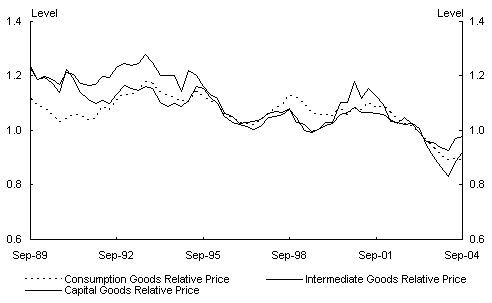
Source: Australian Bureau of Statistics 2004, Balance of Payments and International Investment Position, cat.no.5302.0, Canberra.
Australian Bureau of Statistics 2004, National Income Expenditure and Product, cat. no. 5206.0, Canberra.
Definitions: The relative prices are derived by dividing the import price by the domestic price for each category.
Other drivers
Imports have become a larger proportion of expenditure in most advanced economies over recent decades, notwithstanding their differing experiences of exchange rate movements and growth in incomes. This suggests there are factors other than income and prices at work. These other effects can be categorised as either changes in tastes, changes in the composition of domestic expenditure, specialisation and international integration of firms or reduced impediments to trade.
For the Australian case, using plausible estimates from the above discussion of an income elasticity of 1.2 and a price elasticity of - explains only part of the rise in the proportion of expenditure that goes on imported goods.10
Chart 7 shows the increase in real imports relative to that of GNE. Were imports to have grown at the same rate as GNE, the share would have been constant. The lower wedge shows the effect of the income elasticity being greater than one. The middle wedge shows the effect of relative prices, which contributed most to the growth in imports around 2003 when the exchange rate appreciated markedly. The top wedge, the remainder, includes the effects of other influences such as tastes and specialisation.
Chart 7: Imports of goods: actual vs estimated
(constant prices; percentage of GNE)
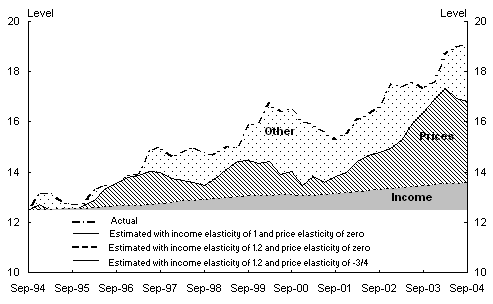
Sourc
e: Australian Bureau of Statistics 2004, Balance of Payments and International Investment Position, cat.no.5302.0, Canberra.
Australian Bureau of Statistics 2004, National Income Expenditure and Product, cat. no. 5206.0, Canberra.
Consumers may now prefer more imported goods, either because of an increased interest in diversity, more cosmopolitan tastes (immigration from non-Anglo-Saxon cultures may be adding to this) or demands for new goods (for example, plasma TV screens and mobile phones) that are not (yet) made domestically. Krugman (1989) has stressed the importance of new goods (‘product proliferation’) in the growth of GDP and the faster growth of imports.
An example of increased imports due to changing tastes is the increase in imports of pharmaceutical goods (which have increased from around 2percent to 5percent of the total value of imported goods over the past 10 to 15 years) which presumably at least partly reflects longer life expectancies and the ageing of the ‘baby boom’ cohort.
Increased specialisation has increased both imports and exports of final goods. International integration by firms has increased both imports and exports of raw materials and components. Globalisation means firms are now moving components around the world more, as more goods have been ‘commoditised’. This has been facilitated by the reduction of some barriers to trade. Tariffs are generally lower, reflecting both global reductions and bilateral free trade agreements, and non-tariff barriers have also been reduced. Some transport bottlenecks have been widened and the cost of transport reduced. Trade has also been assisted by wider availability of credit, better communications, fairer and more certain legal processes and reduced corruption in many parts of the world.
Conclusion
Over the past decade the volume of imported goods grew by an average rate of 9percent a year, while real GNE grew by 4 per cent. While a large part of the fast growth in imports can be explained by rising incomes and falling relative prices, other factors such as changes in tastes and specialisation have also played an important role.
References
Dark, D and Hawkins, J 2005, ‘Econometric analysis of Australian imports’, draft in preparation.
Dwyer, J and Kent, C 1993, ‘A re-examination of the determinants of Australia’s Imports’, Reserve Bank of Australia, Research Discussion Paper, No. 9301, December.
Guttmann, S and Richards, A 2004, ‘Trade openness: an Australian perspective’, Reserve Bank of Australia, Research Discussion Paper, No. 2004-11, December.
Hooper, P, Johnson, K and Marquez, J 1998, ‘Trade elasticities for G-7 countries’, International Finance Discussion Paper, No. 609, Board of Governors of the Federal Reserve System, April.
Krugman, P 1989, ‘Differences in income elasticities and trends in real exchange rates’, European Economic Review, 33, pp. 1055-85.
Macfarlane, I 1979, ‘The balance of payments in the 1970s’, Conference in Applied Economic Research, Reserve Bank of Australia, Sydney, pp. 2-28.
Menon, J 1993 ‘Import price and activity elasticities for the MONASH Model: Johansen FIML estimation of cointegration vectors’, Preliminary Working Paper, No. IP-58, Centre of Policy Studies, Monash University.
Senhadji, A 1997, ‘Time-series estimation of structural import demand equations: A cross-country analysis’, IMF Working Paper, No. 97/132, International Monetary Fund.
Vamplew, W 1987, Australians: Historical Statistics. Fairfax, Syme and Weldon Associates.
1 The authors are from Domestic Economy Division, Australian Government Treasury. This article has benefited from comments and suggestions provided by David Gruen, StevenKennedy, Stephen Miners, Leanne Neo, Martin Parkinson and Meghan Quinn. JaneLove prepared the charts. The views in this article are those of the authors and not necessarily those of the Australian Government Treasury.
2 Information on the composition of imports is given by the Australian Bureau of Statistics in its monthly publication, International Trade in Goods and Services cat. no. 5368.0.
3 Some of the surge in computer imports in the late 1990s reflects bringing forward purchases to have Y2K-compliant systems.
4 Imports were unusually low during the depressions of the 1890s and early 1930s and during the two World Wars. They were unusually high following the gold discoveries of the 1850s and when domestic incomes were boosted by high commodity prices associated with the Korean War of the early 1950s.
5 Over the past decade, there has been a fairly steady increase in incomes and a strong tendency for declines in relative prices. (The correlation between the level of real GNE and a time trend over the past decade is 0.99 and the correlation between GNE and the relative price measure shown in Chart 4 is -0.85.) It is therefore difficult to distinguish the income and price effects from the longer term structural changes. The econometric estimates will suffer from multicollinearity.
6 Over the medium term, changes in the composition of domestic demand have not been that large and there is no evidence that import-intensive components of demand have increased in importance. Compositional effects are therefore unlikely to explain much of the increase in imports.
7 The elasticity refers to the percentage increase in imports arising from a 1 per cent increase in incomes or total spending. It differs from the ‘marginal propensity to import’ (MPM); the dollar increase in imports for a dollar increase in income. As imports of goods are currently around one-sixth of income in Australia, an elasticity of 1.2 translates into an MPM of 0.20.
8 They also cite some other cross-country studies reaching a similar conclusion.
9 This may be an underestimate as it assumes, for example, that the same proportion of food consumed by wealthy households is imported as the proportion for poorer households.
10 To explain fully the rise in imports (and continuing to assume a price elasticity of -) would require an income elasticity of 1.6. This looks implausibly high given the discussion above.